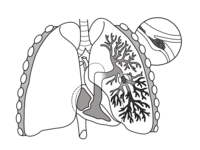
Photo from wikipedia
Background: Pulmonary embolism (PE) is frequently associated with cancer. This study aimed to assess patients with acute PE and identify diagnostic predictors of new cancer after 1 year of follow-up.… Click to show full abstract
Background: Pulmonary embolism (PE) is frequently associated with cancer. This study aimed to assess patients with acute PE and identify diagnostic predictors of new cancer after 1 year of follow-up. Methods: One hundred and twenty-one patients with PE were enrolled consecutively from the emergency department of a single medical center in Taiwan. Data from computed tomography angiography, echocardiogram, electrocardiogram and for baseline comorbidities, clinical presentation, and laboratory parameters were recorded. The surviving discharged patients without a cancer diagnosis were followed-up for 1 year, and new malignancies were recorded. Results: Of 121 patients with acute PE, 44 (36%) had an underlying cancer history (cancer group), and 77 (64%) did not (noncancer group). Baseline demographic characteristics, comorbidities, clinical symptoms, biochemical parameters, echocardiogram data, and electrocardiogram data of the two groups were similar except for a higher hospital mortality rate (56.8% vs 9.1%; p < 0.001), lower body mass index (22.6 ± 4.1 vs 25.5 ± 4.9; p =0.02), higher systolic blood pressure (139.7 ± 33.7 vs 125.4 ± 24.1; p = 0.02), lower low-density lipoprotein level (67.4 ± 38.3 vs 90.4 ± 33.8; p = 0.04), lower creatinine kinase (CK; 43.0 ± 43.0 vs 83.5 ± 83.1; p = 0.01), higher myocardial band (MB) form of CK ratio (0.2 ± 0.2 vs 0.1 ± 0.1; p < 0.01), higher partial pressure of arterial oxygen (122.81 ± 81.2 vs 90.2 ± 59.4; p = 0.03), and less presentation of chest pain (15.9% vs 40.3%; p = 0.01) in the cancer group. Kaplan–Meier curve analysis revealed that the 30-day survival rate was higher in the noncancer group than in the cancer group (log-rank p = 0.04). After 1 year of follow-up, 6 of 59 (10.17%) initial non–cancer-related PE survivors were diagnosed with malignancies. After multivariate analysis, only the initial CK-MB level was associated with a diagnosis of new cancer (hazard ratio [HR]: 1.37, 95% confidence interval [CI]: 1.029–1.811; p = 0.03). Conclusion: This study suggests that the CK-MB level is associated with future malignancy in patients with PE. Patients with cancer-related PE had a worse 30-day survival rate.
Journal Title: Journal of the Chinese Medical Association
Year Published: 2020
Link to full text (if available)
Share on Social Media: Sign Up to like & get
recommendations!